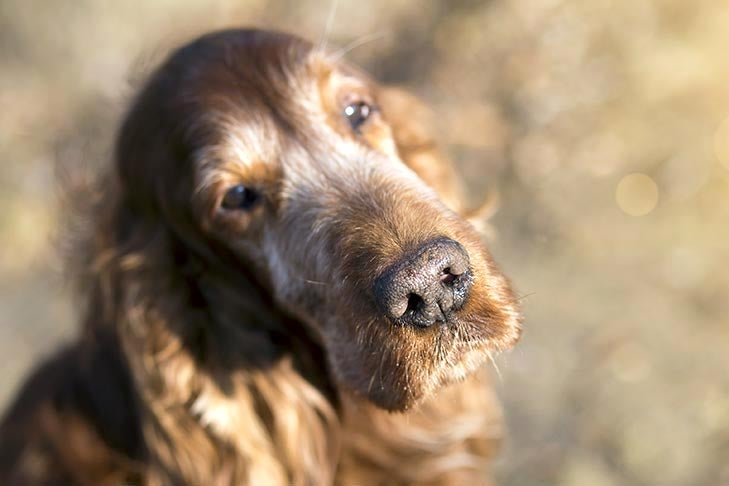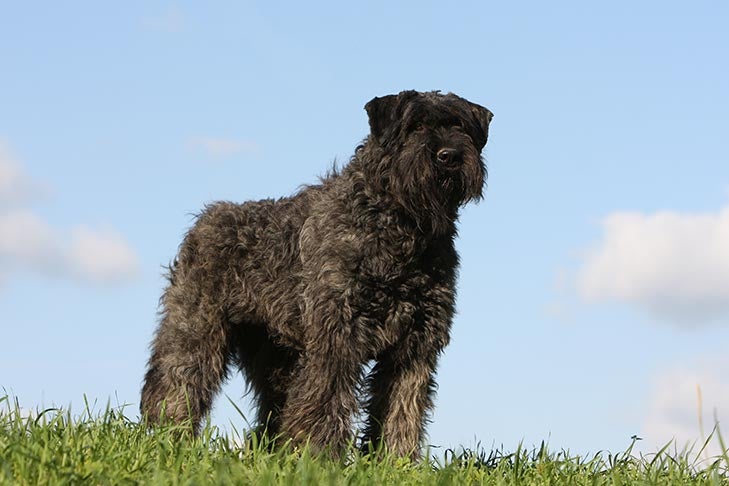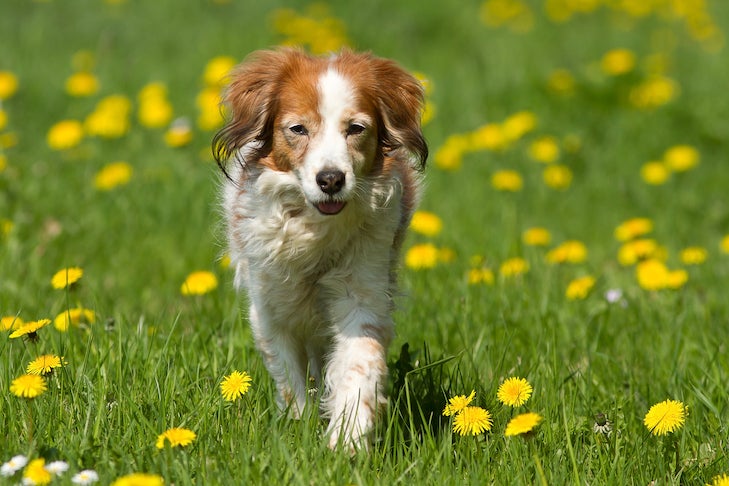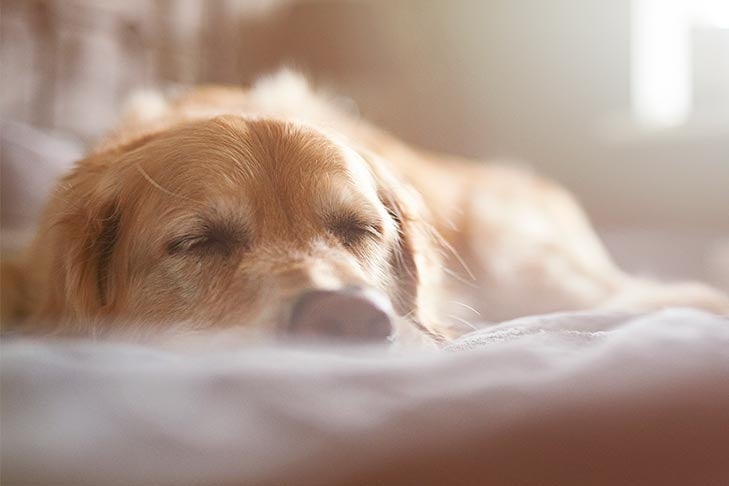
A young vet assistant carried my Lab, Fergus, into a room set aside for euthanasia. While Fergus lay on a large, soft pillow, I lay down beside him. I told him what a good guy he was and how I loved him. How he was a perfect dog—so gentle, so loving, so spiteful, so intense, and always so easy to be with. I told him how I would miss him and how much the other dogs loved him. How he had been such a comfort to so many of my patients over the past 14 years and how many had wondered how he was doing and why he hadn’t been coming to the office any longer. How I had to explain that he could not always hold his urine.
My friend John and I carried him from the car together to the waiting grave. It was a cold, autumn day with rain coming down in buckets, and I thought, “How awful to be buried on such a day.”
Then I remembered whose funeral it was and I thought, “How wonderful. His favorite kind of weather.” Fergus could stand out in this all day—if it were up to him, he’d be lying in his plastic swimming pool while the rain came down.
Fergus is buried alongside my Bouvier, Élodie, whose ashes I’ve had in the house since her death from lymphoma. I placed her next to him and add his favorite raggedy doll from puppyhood and one of his pillows. What a fitting finale: both now at rest.
The other dogs were silent in the house during this brief ceremony. We covered the grave with metal roof sheeting and rocks to protect it from wild animals. None of the dogs ate their dinners that evening. Charlotte even let Dova share the bed—a rare act of kindness on her behalf. The rain continued through the moonless night.
The next day, I brought the dogs over to the grave, sure that they would sense Fergus’s proximity. Charlotte stopped about 20 feet before the grave and refused to go further. I sat on a bench overlooking the river, which was roaring wildly from the cascades of rain the day before.
Dova ran to the grave, sniffed, and took off running around the property, searching. She galloped back and looked along the river, continuing to search before returning to the house.
Then Broodje walked over to the grave. His massive silhouette looked like he was standing at attention in his funeral black. He bent his head down the way people do at gravesites and remained that way for several minutes. It was a beautiful sight—a dog bowed in reverence, like a friend and family member saying a last goodbye. If it were a photograph, it would need no explanation.
Charlotte would not approach the grave. Instead, I found her in the backyard lying in Fergus’s plastic swim pool—something I’d never seen her do before.
Five days later, the dogs remained subdued. Dova threw up her meal and Charlotte didn’t eat. They were waiting, the way I imagine they wait when I am not home. Now they are waiting for Fergus. I don’t know if dogs work through their feelings of loss in the same way that humans do. Or if the passage of time whittles down their memories.
In each place we frequent—the house, the backyard, the apartment, the car, the office—each dog has their own space. Charlotte has her chairs and the bed, Dova is usually on the floor, a safe distance from Charlotte’s reprimands, and Broodje at the entrance to whichever room has activity. No one has attempted to take over the space left vacant by the death of Fergus.

Grief and Loss in a Pandemic World
For people dying in a hospital or nursing home, the traditional rituals have evaporated into a world of uncertainty. Normally as someone lay dying, family, friends, and possibly a religious leader would be present to comfort the dying person. People would offer their last goodbyes—via handholding, a final kiss, a final uttering. The pandemic has prevented us all from visiting loved ones in a hospital or nursing home, so these rituals aren’t possible. We can’t attend a religious service in a church, synagogue, or mosque. Or gather around the grave, with final prayers and eulogies. The very acts that help us grieve and deal with death are forbidden.
The New Normal of Dog Loss
Vets all over the country have responded to the special needs of the pandemic adhering to the same social-distancing rules that are now familiar to all of us.
While observing the restrictions set in place, vets outside the large cities have arranged a drive-in euthanasia process. Dog owners can bring the dog in their car and park in the animal hospital parking area.
Those with small dogs have the injection procedure done in the car. As in earlier times, people with their dogs are given as much time as they need to say goodbye and then phone into the building for personnel to administer the euthanasia in the car. A favorite toy or blanket can be in the car and the pet can be hugged, kissed, whispered to, or rest next to the owner before, during and after the procedure is administered.
Unfortunately, that’s not the case with larger dogs. The final goodbyes occur in the car and then the owner signals it is time for someone to come and collect the dog and go inside the building to perform what is necessary.
Ask for Forgiveness
For patients who have lost a family member or pet during the Coronavirus, I have suggested that they might consider asking the deceased for forgiveness for not being able to be there when they died.
The thought of a pet dying alone from euthanasia—for a relationship of love and loyalty to end in emptiness and disconnect—is devastating. So plan a time by yourself to speak to your beloved, departed dog. Ask them to forgive you for not being allowed to be there together in the last moments of life—to rock them in your arms, lulling them into the deep sleep before the final physical separation.
Your dog will forgive you—I guarantee it. You may even be surprised to find a new level of forgiveness for yourself.
Depending on the circumstances you might include asking for:
- Forgiveness for not being able to offer a final favorite meal.
- Forgiveness for not taking that last really great walk you both loved.
- Forgiveness for not turning your phone off and paying more attention to those special moments with your dog.
- Forgiveness for having to go to work every day and those daily goodbyes and the look you got as the door closed.
A helpful way to think about this unimaginable loss is to consider formalizing some ceremony or ritual where you ask your pet for forgiveness for not being allowed to remain together during the euthanasia.
If you give yourself time to connect to your grief and connect to your tears, you will find your particular symphony of forgiveness for you beloved lost pet. As you experience those feelings, find your own way to design a ceremony of forgiveness honoring your pet and allow the mourning process to begin.

Death and Dying: A Tough Subject
How we regard death and dying is changing rapidly—perhaps only temporarily but also perhaps forever. Previously, we’ve been able to be together in mourning our loved ones, both human and animal. Now we’re often facing grief separately and alone, while also dealing with the fear of what’s to come
Putting down a dog or other pet in these trying times can be even more agonizing and terrifying. But by exploring changes in dealing with death and dying, grief and loss in light of the current pandemic, we’ll hopefully find some helpful ideas on how to work through it.
There is a major difference between grieving and mourning. Frequently, these terms are used interchangeably without much attention being paid to their true meanings. Grieving is an internal process of feeling the feelings and having thoughts related to the deceased person or animal. Grief remains inside a person—it’s extremely personal and may be experienced only inside a person without having to be expressed externally.
Mourning is the externalization or expressing grief to another person. Going through the rituals, religious or not, for a funeral, ceremony, and burial or cremation is the process of mourning. Mourning allows you to process your grief and start to move on. Grieving is allowed to turn into mourning, which allows one to begin coming to terms with the loss of a person.
Finding Ways to Cope
Not only do we each view death differently, we also have different styles of mourning. Frequently, people revert to the rituals they witnessed in their families while growing up. Often couples become upset with each other about how they choose to handle their grief behaviors and responses. Everyone is entitled to their own way of mourning and there is no right way. Don’t argue about differences—just respect them.
Make sure to talk to friends and relatives who will understand what this loss is like for you. Express both your thoughts and your feelings. You could do this through writing a pet obituary capturing what was so special to you about your dog. Or look through photos and watch videos. It can also help to save something special that belonged to the dog that will remind you of great memories—I have saved all of my dogs’ tags.
Consider making a donation or tribute in your pet’s name. Enjoy your favorite comfort foods, with portion control in mind. Exercise will also help move your brain to a better place.
And remember that tears are healthy—they connect your body and your brain. Though they may seem to come out of nowhere, tears are a normal reaction and indicate that you are allowing yourself to feel.
A Fitting Farewell
If possible, instead of a mourning ceremony, have a celebration of life for your dog. In times of social distancing, organize a Zoom or plan a small gathering of 10 or less people who knew and loved your dog. Gather to celebrate what was most joyous and unique about that wonderful relationship with your dog. Be sure to include some delicious comfort foods and drink.
When Élodie, my wonderful Bouvier, had to be put down, I buried her on my country property. There was a quiet burial with a few friends. Troll, my Lab, and Charlotte the younger Bouvier were there. I am convinced the dogs knew what was happening and could not be more respectful—remaining silent and calm the whole time.
A few months later, we held a memorial celebration for Élodie and invited all of her pups from her litters to the celebration. They all showed up. My friend Kathleen, a spiritual director, conducted the service and invited each person to tell the group what their Bouvier meant to them. It remains a cherished memory for me and a dedication to the love Élodie spread everywhere.

Dealing with Guilt
Work to get rid of guilt. Look for underlying feelings that you may be covering up, such as fear, anger, hopelessness, and helplessness. The more you allow your feelings to flow, the less chance you’ll have of moving into guilt and depression.
Don’t blame yourself by asking if you should have paid more attention and seen your dog’s death coming. Any derivatives of these thoughts are usually an attempt to control a situation that was completely out of your control.
Understanding the difference between sadness and depression can also be helpful.
Sadness is usually felt in the upper chest and more often around the heart—a broken heart, heartache, a feeling of shyness, wanting to cry, or just bursting into tears. Acknowledge that your loss and spontaneous crying are perfectly normal.
Depression manifests as feelings of dread, weakness, and excessive anxiety—sometimes with obsessive thinking or compulsive behavior. You may experience a decreased interest in activities and being with people, accompanied by loss of appetite and beginnings of insomnia, and difficulty getting out of bed in the morning.
If you are not sure, check in with a psychiatrist. You might need medication to help you get over a hump in dealing with your loss. And if you find your grief is not diminishing after a few months, consider going to therapy, which can be a great comfort and help you get to insights you might not arrive at on your own.
How to Help Someone Grieve Their Dog
Well-meaning people would ask me what I needed or if there was anything they could do to help in my time of loss. But, overcome with grief, I could never answer that question and would just tell them I was okay. The most comforting gestures came from the people who made specific offers, or just showed up with whatever they thought I would like.
Healing
If you are currently grieving, it is important to give yourself time. Healing comes with time and it helps to remember although your dog is no longer physically with you, he or she will always live inside your heart and will always be in your memories. Celebrate anniversaries with the joy you had together.
* * * * * * *
Dr Joel Gavriele-Gold is a Clinical Psychologist and Psychoanalyst in private practice in New York City along with his Bouviers des Flandres, Argos, and LuLu. Dr Gold is the moderator for the AKC Pet Loss Support Group on Facebook.
The AKC is here to help owners with questions and concerns about COVID-19 and dogs. Find answers to your questions, plus at-home activity ideas, training tips, educational resources, and more on our Coping With COVID-19 hub.
This article is intended solely as general guidance, and does not constitute health or other professional advice. Individual situations and applicable laws vary by jurisdiction, and you are encouraged to obtain appropriate advice from qualified professionals in the applicable jurisdictions. We make no representations or warranties concerning any course of action taken by any person following or otherwise using the information offered or provided in this article, including any such information associated with and provided in connection with third-party products, and we will not be liable for any direct, indirect, consequential, special, exemplary or other damages that may result, including but not limited to economic loss, injury, illness or death.


There is no greater agony than bearing an untold story inside you. —Maya Angelou